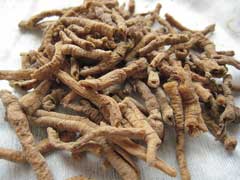 |
|
www.flickr.com/photos/jennyhsu47 |
 |
|
Translate this page:
Summary
Physical Characteristics

 Polygala tenuifolia is a PERENNIAL growing to 0.2 m (0ft 8in) by 0.2 m (0ft 8in).
Polygala tenuifolia is a PERENNIAL growing to 0.2 m (0ft 8in) by 0.2 m (0ft 8in).
See above for USDA hardiness. It is hardy to UK zone 6. The species is hermaphrodite (has both male and female organs).
Suitable for: light (sandy), medium (loamy) and heavy (clay) soils and prefers well-drained soil. Suitable pH: mildly acid, neutral and basic (mildly alkaline) soils. It can grow in semi-shade (light woodland) or no shade. It prefers moist soil.
UK Hardiness Map
US Hardiness Map
Synonyms
Plant Habitats
Cultivated Beds;
Edible Uses
Edible Parts: Leaves Root
Edible Uses:
Young leaves - cooked[105, 177, 179]. Root - cooked[105, 177]. The core is removed and the root is boiled in several changes of water[179].
References More on Edible Uses
Medicinal Uses
Plants For A Future can not take any responsibility for any adverse effects from the use of plants. Always seek advice from a professional before using a plant medicinally.
Cardiotonic Expectorant Haemolytic Kidney Sedative Tonic
Yuan Zhi contains triterpenoid saponins, these promote the clearing of phlegm from the bronchial tubes. The plant is used mainly as an expectorant and stimulant to treat bronchial asthma, chronic bronchitis and whooping cough[254]. The root is antibacterial, cardiotonic, cerebrotonic, expectorant, haemolytic, hypotensive, sedative and tonic[116, 147, 176, 218]. It acts mainly as a tonic for the heart and kidney energies[238]. It is taken internally in the treatment of coughs with profuse phlegm, bronchitis, insomnia, palpitations, poor memory, anxiety, depression and nervous tension[238]. Externally it is used to treat boils and carbuncles[147, 238]. The root is harvested in the autumn and dried for later use[238]. The leaves are used as a tonic for the kidneys[218].
References More on Medicinal Uses
The Bookshop: Edible Plant Books
Our Latest books on Perennial Plants For Food Forests and Permaculture Gardens in paperback or digital formats.

Edible Tropical Plants
Food Forest Plants for Hotter Conditions: 250+ Plants For Tropical Food Forests & Permaculture Gardens.
More

Edible Temperate Plants
Plants for Your Food Forest: 500 Plants for Temperate Food Forests & Permaculture Gardens.
More

More Books
PFAF have eight books available in paperback and digital formats. Browse the shop for more information.
Shop Now
Other Uses
References More on Other Uses
Cultivation details
Prefers a moderately fertile moisture-retentive well-drained soil, succeeding in full sun if the soil remains moist throughout the growing season, otherwise it is best in semi-shade[200, 238]. Dislikes shade according to another report. Plants are hardy to at least -15°c[238].
References Carbon Farming Information and Carbon Sequestration Information
Temperature Converter
Type a value in the Celsius field to convert the value to Fahrenheit:
Fahrenheit:
The PFAF Bookshop
Plants For A Future have a number of books available in paperback and digital form. Book titles include Edible Plants, Edible Perennials, Edible Trees,Edible Shrubs, Woodland Gardening, and Temperate Food Forest Plants. Our new book is Food Forest Plants For Hotter Conditions (Tropical and Sub-Tropical).
Shop Now
Plant Propagation
Seed - sow spring or autumn in a cold frame[214]. When they are large enough to handle, prick the seedlings out into individual pots and grow them on in the greenhouse for their first winter. Plant them out into their permanent positions in late spring or early summer, after the last expected frosts. Division. Cuttings of young shoots in a frame in late spring[1].
Other Names
If available other names are mentioned here
Native Range
TEMPERATE ASIA: Russian Federation (Buryatia, Gorno-Altay, Tyva, Respublika, Krasnoyarsk (south), Chita, Irkutsk), Mongolia, Russian Federation (Amur, Primorye), China (Gansu Sheng, Hebei Sheng, Heilongjiang Sheng, Henan Sheng, Jiangxi Sheng, Liaoning Sheng, Nei Mongol Zizhiqu, Ningxia Huizi Zizhiqu, Qinghai Sheng, Shaanxi Sheng, Shanxi Sheng, Sichuan Sheng), Korea
Weed Potential
Right plant wrong place. We are currently updating this section.
Please note that a plant may be invasive in one area but may not in your area so it's worth checking.
Conservation Status
IUCN Red List of Threatened Plants Status :

Growth: S = slow M = medium F = fast. Soil: L = light (sandy) M = medium H = heavy (clay). pH: A = acid N = neutral B = basic (alkaline). Shade: F = full shade S = semi-shade N = no shade. Moisture: D = dry M = Moist We = wet Wa = water.
Now available:
Food Forest Plants for Mediterranean Conditions
350+ Perennial Plants For Mediterranean and Drier Food Forests and Permaculture Gardens.
[Paperback and eBook]
This is the third in Plants For A Future's series of plant guides for food forests tailored to
specific climate zones. Following volumes on temperate and tropical ecosystems, this book focuses
on species suited to Mediterranean conditions—regions with hot, dry summers and cool, wet winters,
often facing the added challenge of climate change.
Read More
Expert comment
Author
Willd.
Botanical References
Links / References
For a list of references used on this page please go here
Readers comment